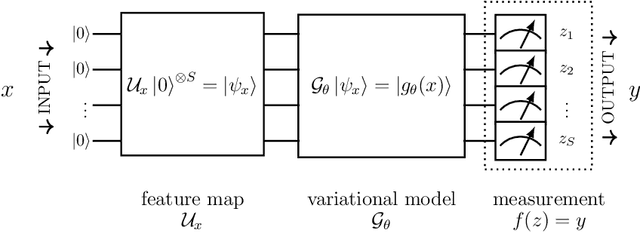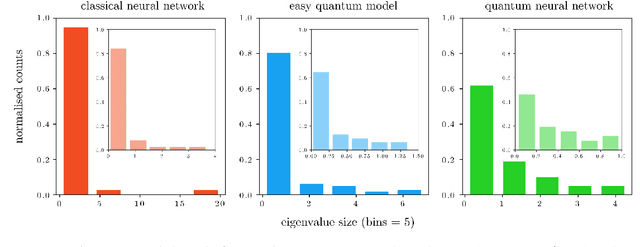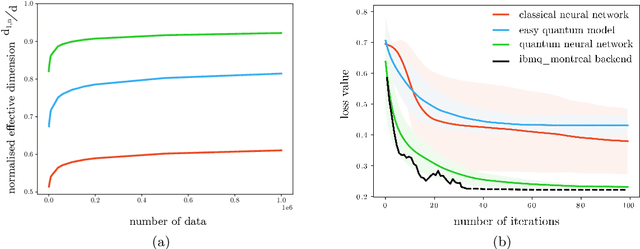Christa Zoufal
Quantum Theory and Application of Contextual Optimal Transport
Feb 22, 2024Abstract:Optimal Transport (OT) has fueled machine learning (ML) applications across many domains. In cases where paired data measurements ($\mu$, $\nu$) are coupled to a context variable $p_i$ , one may aspire to learn a global transportation map that can be parameterized through a potentially unseen con-text. Existing approaches utilize Neural OT and largely rely on Brenier's theorem. Here, we propose a first-of-its-kind quantum computing formulation for amortized optimization of contextualized transportation plans. We exploit a direct link between doubly stochastic matrices and unitary operators thus finding a natural connection between OT and quantum computation. We verify our method on synthetic and real data, by predicting variations in cell type distributions parameterized through drug dosage as context. Our comparisons to several baselines reveal that our method can capture dose-induced variations in cell distributions, even to some extent when dosages are extrapolated and sometimes with performance similar to the best classical models. In summary, this is a first step toward learning to predict contextualized transportation plans through quantum.
Quantum Kernel Alignment with Stochastic Gradient Descent
Apr 19, 2023Abstract:Quantum support vector machines have the potential to achieve a quantum speedup for solving certain machine learning problems. The key challenge for doing so is finding good quantum kernels for a given data set -- a task called kernel alignment. In this paper we study this problem using the Pegasos algorithm, which is an algorithm that uses stochastic gradient descent to solve the support vector machine optimization problem. We extend Pegasos to the quantum case and and demonstrate its effectiveness for kernel alignment. Unlike previous work which performs kernel alignment by training a QSVM within an outer optimization loop, we show that using Pegasos it is possible to simultaneously train the support vector machine and align the kernel. Our experiments show that this approach is capable of aligning quantum feature maps with high accuracy, and outperforms existing quantum kernel alignment techniques. Specifically, we demonstrate that Pegasos is particularly effective for non-stationary data, which is an important challenge in real-world applications.
On Quantum Circuits for Discrete Graphical Models
Jun 01, 2022


Abstract:Graphical models are useful tools for describing structured high-dimensional probability distributions. Development of efficient algorithms for generating unbiased and independent samples from graphical models remains an active research topic. Sampling from graphical models that describe the statistics of discrete variables is a particularly challenging problem, which is intractable in the presence of high dimensions. In this work, we provide the first method that allows one to provably generate unbiased and independent samples from general discrete factor models with a quantum circuit. Our method is compatible with multi-body interactions and its success probability does not depend on the number of variables. To this end, we identify a novel embedding of the graphical model into unitary operators and provide rigorous guarantees on the resulting quantum state. Moreover, we prove a unitary Hammersley-Clifford theorem -- showing that our quantum embedding factorizes over the cliques of the underlying conditional independence structure. Importantly, the quantum embedding allows for maximum likelihood learning as well as maximum a posteriori state approximation via state-of-the-art hybrid quantum-classical methods. Finally, the proposed quantum method can be implemented on current quantum processors. Experiments with quantum simulation as well as actual quantum hardware show that our method can carry out sampling and parameter learning on quantum computers.
The power of quantum neural networks
Oct 30, 2020



Abstract:Fault-tolerant quantum computers offer the promise of dramatically improving machine learning through speed-ups in computation or improved model scalability. In the near-term, however, the benefits of quantum machine learning are not so clear. Understanding expressibility and trainability of quantum models-and quantum neural networks in particular-requires further investigation. In this work, we use tools from information geometry to define a notion of expressibility for quantum and classical models. The effective dimension, which depends on the Fisher information, is used to prove a novel generalisation bound and establish a robust measure of expressibility. We show that quantum neural networks are able to achieve a significantly better effective dimension than comparable classical neural networks. To then assess the trainability of quantum models, we connect the Fisher information spectrum to barren plateaus, the problem of vanishing gradients. Importantly, certain quantum neural networks can show resilience to this phenomenon and train faster than classical models due to their favourable optimisation landscapes, captured by a more evenly spread Fisher information spectrum. Our work is the first to demonstrate that well-designed quantum neural networks offer an advantage over classical neural networks through a higher effective dimension and faster training ability, which we verify on real quantum hardware.
 Add to Chrome
Add to Chrome Add to Firefox
Add to Firefox Add to Edge
Add to Edge